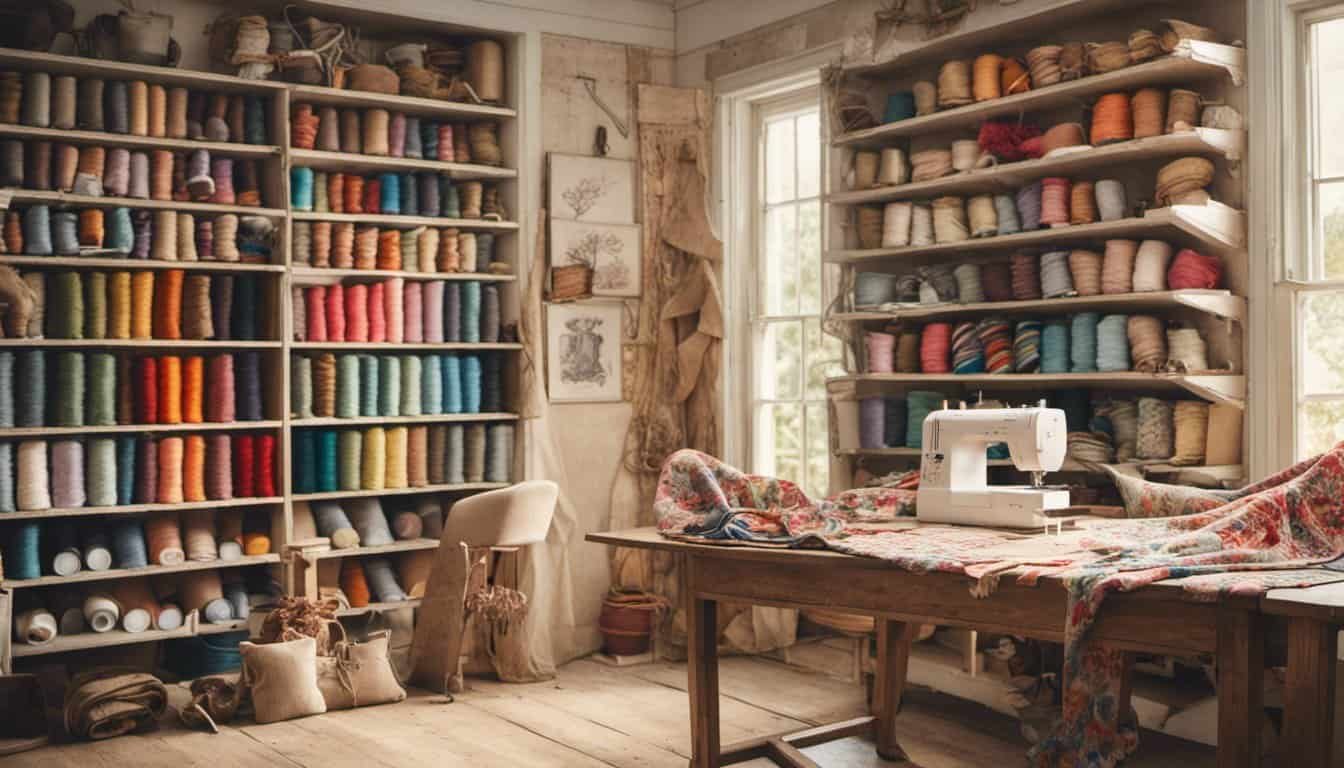Ever been frustrated by thread bunching while sewing? It can turn a smooth project into a tangled mess in no time. But don’t worry, you’re not alone and there are simple fixes to keep your work flowing effortlessly.
Whether you’re a seasoned seamstress or just starting out, understanding why thread bunching happens is key. With a few tweaks to your technique and some handy tips, you’ll be back to creating beautiful stitches without the hassle.
Let’s dive into what causes thread to bunch and the best ways to tackle it, so you can sew with confidence and ease.
Understanding Thread Bunching
Thread bunching occurs when excess thread gathers on the underside of your fabric, disrupting seams and creating uneven stitches. Recognizing thread bunching involves observing puckers or loops along your sewing line, which can vary in size from small wrinkles to large, noticeable bulges.
Common Causes of Thread Bunching
- Incorrect Tension Settings
- Top thread tension too high creates tight stitches, while too low tension allows the bobbin thread to pull loose.
- Incompatible Thread Types
- Using heavy threads with fine needles leads to uneven stitching and bunching.
- Worn or Damaged Needles
- Dull needles increase friction, causing threads to snag and accumulate.
- Improper Threading
- Incorrect threading of the machine disrupts the balance between top and bobbin threads, resulting in bunching.
- Feed Dog Issues
- Dirty or malfunctioning feed dogs fail to move fabric smoothly, allowing threads to pile up.
Identifying Thread Bunching
Visual Inspection
- Look for irregularities along seams where threads appear raised or warped.
Tactile Check
- Run your fingers along the seam to feel for lumps or uneven areas indicating hidden bunching.
Stitch Consistency
- Monitor stitch uniformity; inconsistent stitches often signal underlying bunching problems.
Preventing Thread Bunching
- Regularly clean and maintain your sewing machine to ensure smooth operation.
- Use quality threads appropriate for your fabric type and project requirements.
- Replace needles frequently to avoid wear-related complications.
- Double-check thread tension settings before starting each project to match your specific sewing needs.
By understanding the causes and identification methods for thread bunching, you can take proactive steps to maintain smooth and professional-quality stitching in your sewing projects.
Common Causes
Thread bunching stems from several key factors affecting your sewing machine’s performance. Understanding these causes helps you address and prevent thread jams effectively.
Improper Tension Settings
Incorrect tension settings disrupt the balance between upper and lower threads. High upper tension causes loops to form under the fabric, leading to bunching. Low lower tension fails to secure the stitches properly, resulting in uneven seams. Adjust both tensions according to your thread type and fabric weight. Refer to your machine’s manual for specific tension guidelines.
Needle Issues
Using a dull or bent needle compromises stitch formation and thread flow. A damaged needle may not penetrate the fabric smoothly, causing threads to bunch beneath the surface. Additionally, selecting the wrong needle size for your project strains the machine, resulting in tension problems. Regularly inspect your needles and replace them after 8 hours of use or when signs of wear appear.
Thread Quality
Low-quality or incompatible threads interfere with consistent stitching. Poorly manufactured threads break easily or create uneven feeds, leading to thread accumulation. Choose high-quality, machine-compatible threads that match your fabric type for optimal performance. Store threads in a cool, dry place to prevent moisture absorption, which weakens thread integrity.
Preventive Measures
Preventing thread bunching ensures smooth stitching and high-quality results. Implement these strategies to minimize issues.
Adjusting Machine Settings
Proper tension settings balance upper and lower threads, preventing loops and uneven seams. Start by setting the upper tension to medium, then gradually adjust the lower tension until stitches appear even. Test on scrap fabric, and fine-tune as needed.
Using Quality Threads
High-quality threads reduce friction and breakage, aiding consistent stitching. Choose polyester or cotton threads compatible with your fabric type. Store threads in a cool, dry place to maintain strength and prevent tangling.
Regular Maintenance
Maintain your sewing machine to ensure optimal performance. Clean the bobbin area and remove lint after each use. Oil the machine monthly, and inspect needles for wear or damage. Replace needles every 8 hours of sewing to maintain sharpness and prevent thread issues.
Fixing Thread Bunching
Address thread bunching promptly to maintain smooth sewing operations. Implement the following solutions to resolve the issue.

Re-threading the Machine
Re-threading your sewing machine ensures proper tension and smooth stitching.
- Turn off the machine and remove all existing thread.
- Follow the machine’s threading diagram accurately.
- Ensure the thread passes through each tension disc without obstruction.
- Thread the needle from front to back, avoiding any twists or tangles.
- Wind a new bobbin and insert it correctly into the bobbin case.
Replacing Needles
Using the correct needle prevents thread bunching and enhances stitch quality.
- Select a needle type suitable for your fabric and thread (e.g., universal, ballpoint).
- Replace needles after every 8 hours of sewing or if they show signs of wear.
- Insert the needle fully into the needle clamp, ensuring it is secure.
- Check for any bends or damages before use to avoid stitching issues.
Removing Bunches
Eliminate existing thread bunches to restore even stitching.
- Turn off the machine and carefully remove the fabric to access the thread.
- Use a lint brush to clear excess threads from the bobbin area and feed dogs.
- Gently pull out any tangled threads to prevent them from reoccurring.
- Rerun the machine on a scrap piece of fabric to ensure the problem is fixed.
Tips and Best Practices
Maintaining optimal sewing conditions minimizes thread bunching. Implement these strategies to enhance your sewing experience:
Adjust Tension Settings
Start with a medium upper tension. Fine-tune lower tension incrementally until stitches align evenly. Consistent tension prevents loops and uneven seams.
Use High-Quality Threads
« Unlock Stunning Designs: The Ultimate Creating Texture with Fabric Inspiration Guide
You Won’t Believe How Easy It Is to Sew Blankets for Charity Donations »
Select polyester or cotton threads. High-quality threads reduce friction and ensure smooth stitching. Store threads in a cool, dry place to maintain strength and prevent tangling.
Replace Needles Regularly
Change needles every 8 hours of sewing or after completing heavy projects. Sharp, correctly sized needles facilitate precise stitch formation. Inspect needles for bends or damage before each use.
Maintain Your Sewing Machine
Clean the bobbin area frequently using a lint brush. Oil the machine monthly according to the manufacturer’s instructions. Regular maintenance ensures reliable performance and reduces thread-related issues.
Proper Threading Technique
Thread the machine correctly, following the manufacturer’s guide. Ensure the thread passes through all necessary guides and tension discs. Proper threading eliminates disruptions in stitch consistency.
Choose Compatible Thread Types
Match thread type to fabric. Use stronger threads like polyester for heavy fabrics and finer threads like cotton for delicate materials. Compatible threads enhance stitch durability and appearance.

Monitor Feed Dog Function
Ensure feed dogs move smoothly. Obstructions or stiffness can cause uneven fabric movement and thread bunching. Regularly check and clean feed dogs to maintain consistent stitching.
Test on Scrap Fabric
Before starting your project, sew a test stitch on scrap fabric. Adjust settings based on test results to achieve optimal stitch quality. Testing prevents issues during the main project.
Organize Thread Spools
Arrange thread spools to prevent tangling and knotting. Use spool holders or organizers to keep threads accessible and orderly. Organized threads facilitate easy selection and threading.
Utilize Proper Lighting
Ensure adequate lighting while sewing. Good visibility helps in precise stitching and quick identification of thread issues. Proper lighting enhances overall sewing accuracy and efficiency.
By following these tips and best practices, you can reduce thread bunching and achieve professional-quality stitching in your sewing projects.

Conclusion
Handling thread bunching doesn’t have to derail your sewing projects. With the right approach and a bit of patience you can keep your stitches smooth and your creations looking great.
Remember to keep your machine well-maintained and choose quality threads to make your sewing experience enjoyable. Each fix you apply brings you one step closer to mastering your craft and creating beautiful garments you can be proud of.
Happy sewing!

















